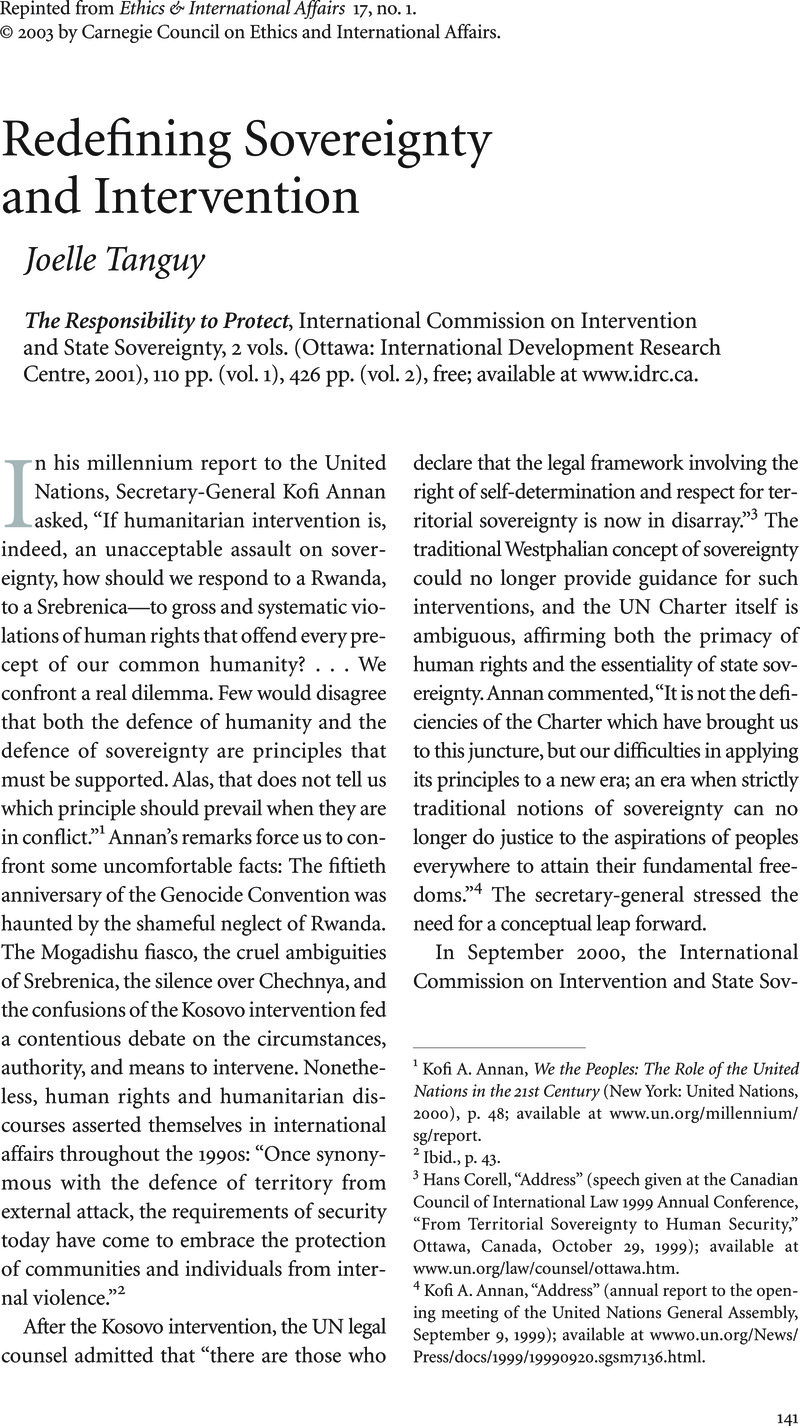Article contents
Redefining Sovereignty and Intervention
Published online by Cambridge University Press: 28 September 2012
Abstract

- Type
- Review Essays
- Information
- Copyright
- Copyright © Carnegie Council for Ethics in International Affairs 2003
References
1 Annan, Kofi A., We the Peoples: The Role of the United Nations in the 21st Century (New York: United Nations, 2000), p. 48Google Scholar; available at http://www.un.org/millennium/sg/report.
2 Ibid., p. 43Google Scholar.
3 Hans Corell, “Address” (speech given at the Canadian Council of International Law 1999 Annual Conference, “From Territorial Sovereignty to Human Security,” Ottawa, Canada, October 29, 1999); available at http://www.un.org/law/counsel/ottawa.htm.
4 Kofi A. Annan, “Address” (annual report to the opening meeting of the United Nations General Assembly, September 9,1999); available at http://wwwo.un.org/News/Press/docs/1999/19990920.Sgsm7136.html.
5 Francis Deng developed the concept in Francis Deng, et al., Sovereignty as Responsibility: Conflict Management in Africa (Washington, D.C.: Brookings Institution Press, 1996Google Scholar).
6 Bettati, Mario and Kouchner, Bernard, Le devoir d'ingérence: peut-on les laisser mourir? (Paris: Denoel, 1987Google Scholar).
7 Reference to Resolution 43/131 of December 8, 1988, regulating delivery of humanitarian assistance to victims of natural disasters and similar emergency situations and insisting on a principle of free access to the victims; and Resolution 45/100 of December 14, 1990, furthering the previous resolution and introducing the concept of emergency humanitarian corridors.
8 For a brilliant account of these issues, see Shawcross, William, Deliver Us from Evil: Peacekeepers, Warlords and a World of Endless Conflict (New York: Simon & Schuster, 2000Google Scholar).
9 Quotedby Shashi Tharoor, “Humanitarian Intervention: Principles, Problems, and Prospects” (speech given at the Wilton Park Conference “Humanitarian Intervention? How Can We Do It Better?” Wilton Park, U.K., February 19–23, 2001); available at http://web.gc.cuny.edu/icissresearch/Wilton.Park.Tharoor.htm.
10 Bettati, Mario, “Une occasion manquée,” Le Monde, November 22, 2001, supplement, p. IIIGoogle Scholar.
11 Gareth Evans, “The Responsibility to Protect and September 11” (speech given at the UNU/Canadian Government Seminar on The Responsibility to Protect, Ottawa, Canada, December 16, 2002); available at http://www.intl-crisis-group.org/projects/showreport.cfm?reportid=860.
12 Camilleri, Joseph and Falk, Jim, End of Sovereignty? The Politics of a Shrinking and Fragmenting World (London: Edward Elgar, 1992), p. 2Google Scholar.
13 International Commission on Intervention and State Sovereignty, synopsis in The Responsibility to Protect (Ottawa: IDRC, 2001), vol. I, p. xiGoogle Scholar.
14 For a look at breaches of humanitarian law by intervening forces in Somalia, see Brauman, Rony, Le crime humanitaire: Somalie (Paris: Arléa, 1993Google Scholar).
15 See Evans, “The Responsibility to Protect and September 11.”
16 This procedure was the basis for operations in Korea in 1950, Egypt in 1956, and the Congo in 1960.
17 This was the case with the interventions of the Economic Community of West African States in Liberia in the early 1990S and in Sierra Leone in 1997.
18 Kofi A. Annan, “Address” (speech given at the International Peace Academy seminar, “Responsibility to Protect,” New York, N.Y., February 15,2002); available at http://www.un.org/News/Press/docs/2002/sgsm8125.doc.htm.
19 Lake, Anthony, “Peacekeeping as Permanent Band-Aid,” in his 6 Nightmares: Real Threats in a Dangerous World and How America Can Meet Them (New York: Little, Brown, and Co., 2000), p. 107–74Google Scholar.
20 Lake, Anthony and Morris, Roger, “The Human Reality of Realpolitik,” Foreign Policy 4 (Fall 1971), pp. 157–62CrossRefGoogle Scholar, analyzed the process whereby American policy-makers with moral sensibilities could wage a war with such immoral consequences as the one in Vietnam. Cited by Samantha Power, “Bystanders to Genocide: Why the United States Let the Rwandan Tragedy Happen,”Atlantic Monthly, September 2001, pp. 84–108; available at http://www.theatlantic.com/issues/2001/09/power.htm.
21 William Ferroggiaro, ed., The US and the Genocide in Rwanda 1994: Evidence of Inaction (National Security Archives, George Washington University, August 20, 2001); available at http://www.gwu.edu/~nsarchiv/NSAEBB/NSAEBB53/index.html.
22 For further discussion of U.S. policy development with regard to Rwanda, see Power, “Bystanders to Genocide”; and Power, Samantha, “A Problem from Hell”: America and the Age of Genocide (New York: Basic Books, 2002Google Scholar).
23 Ignatieff, Michael, “Is the Human Rights Era Ending?” New York Times, February 5, 2002, p. A25Google Scholar.
24 Tony Blair, “Address” (speech given at the annual Labour Party conference, October 2, 2001); available at politics, http://guardian.co.uk/labour2001/story/0,1414,562006,00.html.
25 White House, “Frequently Asked Questions about the War on Terrorism at Home and Abroad”; available at http://www.whitehouse.gov/response/faq-what.html.
26 International Commission on Intervention and State Sovereignty, The Responsibility to Protect, vol. I, p. 12Google Scholar.
27 Ignatieff, “Is the Human Rights Era Ending?”
28 Axworthy, Lloyd, “Beware the Fever of War,” Toronto Globe and Mail, October 8, 2002, p. A23Google Scholar.
- 10
- Cited by




